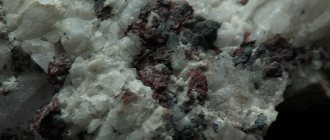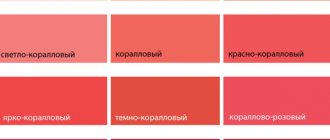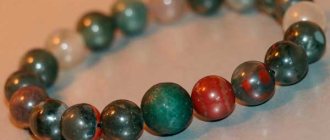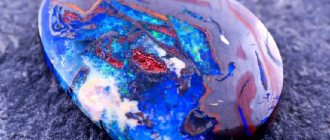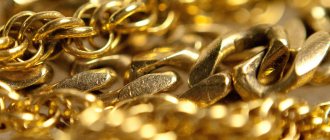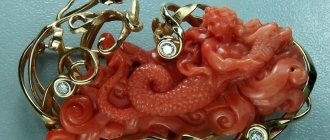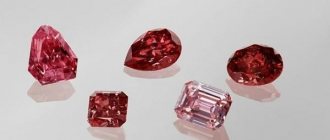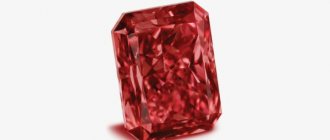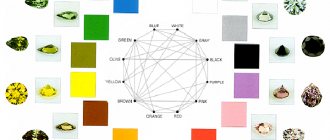Mineral cinnabar - English name - Cinnabar
The name of the mineral is very ancient, presumably originating from India.
Synonyms: Cinnabarite, minium (partially), mercury blende (Hausman, 1813). Varieties of ores containing earthy or organic impurities, an admixture of dolomite, were described as liver mercury ore , combustible mercury ore, coral ore - paragite (Lipold according to Tsefarovich, 1873), brick ore, steel ore.
Cinnabar. Crystals in rock
Crystallographic characteristics
system Trigonal-trapezohedron. class; a : c = 1 : 2.2905 (Ayui).
Crystal structure
The structure is like a distorted NaCl or PbS structure. The Hg ions are surrounded by six S ions in distorted octahedra. The basis of the structure of the cinnabar crystal lattice is endless spiral chains - S-Hg-S-, located || c-axis, along the right or left helical axis, which gives this opaque mineral a strongly pronounced ability to rotate the plane of polarization, much greater than that of quartz. Homopolar bonds between Hg and S of the same chain are much stronger than the bonds between atoms of neighboring chains. The parallel laying of independent helical chains causes a distinct cleavage along the prism.
Main forms:
Crystals of various shapes: rhombohedral or tabular at (0001), less often columnar; in Avala (Yugoslavia), crystals tabular in c are always observed in quartzites, rhombohedral in clays, and prismatic in rock voids; often right and left negative, respectively right and left positive trapezohedrons are found simultaneously, which is due to hidden twinning of right and left crystals; Crystals from Rudnan (Poland) are characterized by the absence of trapezohedral faces.
Cinnabar. Powdery masses
Killer beauty
Nevertheless, this beautiful and easy-to-process mineral was often used in everyday life in ancient times. Blush and lipstick, other cosmetics made for Egyptian and then Roman beauties, included toxic cinnabar as the main dye. Make-up with cinnabar was used by actors of Greek and Roman theaters.
From the point of view of a modern person, a medicine containing cinnabar seems completely incredible. Nevertheless, many medieval doctors brought their unfortunate patients to the grave with precisely such poisonous ointments, pills and potions. they tried to treat leprosy with the mercury component of the mineral cinnabar .
Here is a beautiful Chinese carved cinnabar box that belonged to a certain doctor from the Qing Dynasty (18th century). A round dance of cheerful children is carved on the ends. Apparently, the doctor specialized in healing children, and entertained little patients with such a funny image. The pediatrician's carved accessory was intended for storing miraculous medicines. One can only imagine what the effect of these drugs, saturated with mercury vapor, was.
The box is on display at the Beijing National Museum of China.
Read also: HR administration service
Physical properties
Optical
- Cinnabar color: bright red, crimson red, often patchy brownish red, sometimes lead-gray tarnish
- The line is bright red (like a wet pencil).
- The luster is diamond-like, with a dark color it is metallic, with earthy cinnabar it is matte.
- The tint is matte, sometimes with a slight lead-gray tarnish.
- Transparency The degree of transparency of cinnabar varies greatly. Transparent in thin fragments
Mechanical
- Hardness 2 - 2.5.
- Density 8.0—8.2
- Cleavage according to (1010) is perfect.
- The mineral is fragile
- The cinnabar fracture is vaguely conchoidal, uneven, and sometimes splintered.
Cinnabar. Granular masses in rock
Magical and healing abilities
In ancient times, healers already used the healing properties of cinnabar. A powder was made from it that treated almost all human ailments. However, the medicine was addictive. If the patient did not comply with the dose, he died from an overdose. Now magicians and sorcerers widely use the mineral cinnabar in their work. The main condition for its use is knowledge and strict adherence to the dosage. Contact with the crystal should not exceed 30 seconds.
Mercury blende can cause:
- sexual hunger;
- increased performance;
- activation of vital energy.
Cinnabar also has magical properties. She helps her owner:
- Climb the career ladder.
- Improve your financial situation.
- Gain strength to deal with everyday tasks.
The mineral is able to remove negative energy in the room where it is located.
Chemical properties
Cinnabar is decomposed by aqua regia and chlorine; HCl decomposes very weakly when heated; НNOз and H2SO4 have no effect. It dissolves in a solution of KJ + J and in solutions of caustic alkali sulfides to form complex salts. In an aqueous solution of Na2S, cinnabar is slightly less soluble than metacinnabarite. In polished sections, aqua regia boils and gives an easily erasable coating; other standard reagents are not effective.
A characteristic microchemical reaction: a mixture of Co(NO3)2 • 6H2O + NH4CNS is added to a solution in aqua regia, blue prismatic crystals of the double thiocyanate salt of Co and Hg are formed.
Cinnabar stone: who suits it according to their zodiac sign
Astrologers do not recommend wearing this stone to Scorpios.
All other zodiac signs can use this stone's ability to bring out the good qualities of each sign.
Cinnabar is a mineral that has been known since ancient times. It has come a long way from a universal medicine to a harmful substance, from a material of alchemy to an artist's tool. But throughout his entire existence, he aroused interest in himself and was a human assistant.
Artificial acquisition
Cinnabar is obtained in various ways: by the interaction of H2S and HgCl2 (Durocher, Broderick) or NH4CNS and Hg2Cl2 (Weinschenck), by prolonged standing in air of a solution of mercury sulfate in Na2S (De Koninck), in a sealed tube at 80-90° under the influence of hydrogen sulfide; water onto metallic mercury (Dölter), by heating amorphous HgS with (NH4)2S to 100° in a sealed tube, while neutralizing or diluting a solution containing Na2S with water.
Other properties
Poor conductor of electricity. Dielectric constant 6.27. Photoconductivity is observed, which has a clearly defined anisotropic character. Crystals exposed to light waves of a certain length, when included in an electrical circuit, lose their insulating properties due to an increase in electrical conductivity by millions of times. As the temperature increases, the photoelectric effect boundary shifts toward longer wavelengths. When irradiated by α-particles, pulsed conductivity is excited. HgS is diamagnetic. Positive values of specific magnetic susceptibility from 0.2 • 10-6 to 31.2 • 10-6 CGSM were found in cinnabar, which is probably due to mechanical impurities.
Heating behavior
When heated, cinnabar first turns brown, and at temperatures above 250° it turns black. At 44° and a pressure of 1 atm. reversibly transforms into metacinnabarite. Under strong pressure it does not decompose to the melting point (-1450°).
Industrial uses of cinnabar
Large transparent crystals of this mineral are cut for collection.
This mineral was especially used during the times of alchemists. They tried to extract gold from it and added it to various potions.
Nowadays, cinnabar is used in industry as a source of mercury.
Firing technology makes it possible to extract mercury from a mass of stone. The mineral is heated until condensation forms, which is mercury.
Despite its visual appeal, jewelers do not cut cinnabar into jewelry.
The reason is that this stone is too fragile and the mercury in its composition is dangerous for humans.
However, in ancient times it was used as an ornamental stone. Various figures and decorations were cut out of soft, pliable material.
Small sculptures and boxes from Ancient Rome, Ancient Egypt, Byzantium, medieval China and Europe have survived to this day.
Diagnostic signs
Characterized by bright red color, dash color, high density, behavior in front of the blowpipe. In rounded grains, it differs from cuprite in its reaction to Hg and in its trait: the streak is bright red and does not change color when rubbed; in cuprite, the streak is brownish-red, and when rubbed it turns yellow and green. It differs from kermesite in its brighter red color and negative reaction with KOH (concentrated solution). Under a microscope, in small grains it is similar to proustitis, differs in its attitude to the action of reagents. Can be confused with hematite, however, the latter has a cherry-red streak, higher hardness, and is also absent.
Cinnabar with stibnite in quartz Ukraine
Satellites.
It is found in close association with stibnite, as well as with pyrite, melnikovite-pyrite, marcasite, and less commonly with realgar, arsenopyrite and other sulfides, sometimes with native gold; Of the vein minerals, the companions are mainly quartz (chalcedony), calcite, sometimes barite, often nacrite, and bitumen. Sometimes accompanied by secondary mercury minerals, metacinnabarite. It is also found with fluorite, barite, and dolomite.
Cinnabar: what is it?
Cinnabar is mercury sulfide.
It is the only ore mercury mineral in the world.
The exact origin of its name is unknown.
According to one version, the name comes from the Latin word “cinnabari”, according to another, from the ancient Persian κιννάβαρι, which means “dragon blood”.
This name reflects the special quality of the mineral - when freshly split, its color resembles drops of venous blood.
It is thanks to its color that cinnabar has gained worldwide recognition. What cinnabar is was known in ancient times.
Thousands of years ago, a color pigment was extracted from this mineral, which was used to paint various surfaces.
There is even a separate shade of red - cinnabar color.
Place of Birth
The most widespread deposits are those formed at moderate and shallow depths. Ore bodies are confined to sandstones, shales, quartzites, limestones, and dolomites. In low-temperature hydrothermal deposits, cinnabar forms veins, solid masses, impregnations and deposits in cracks; Often cinnabar secretions are confined to silicified areas. The formation of cinnabar after quartz was noted, with the replacement of quartz and partly calcite in the latest stages of hydrothermal activity. In some deposits pcs. Oregon Idaho Nevada (USA) cinnabar accompanies opal and chalcedony in the form of submicroscopic segregations and was presumably deposited by colloidal solutions at shallow depths.
Cinnabar massive texture Altai Mountains, Chagan-Uzinskoe deposit
Less common is the presence of cinnabar in medium-temperature gold-bearing quartz veins (Ayatskoye deposit, Sverdlovsk region). In medium-temperature deposits, cinnabar is occasionally observed as a secondary mineral formed by mercury-containing fahlores; sometimes replaces hypogene metacinnabarite. The main deposits: Nikitovna (Ukraine), Khaidarkan and Chauvay (Kyrgyzstan), Chagan-Uzunskoye and Aktashskoye (Gorno-Altai Autonomous Region), Dzhizhikrut (Tajikistan). Cinnabar was also installed in the Vyshkovsky and Beregovsky districts of the Transcarpathian region. (Ukraine), along the southern slope of the Main Caucasus Range (Aheiskoe, Talakiani and Bokoe in Georgia). Deposits of global importance: Almaden (Spain), Avala (Serbia), Idria (Italy), New Idria and New Almaden (USA).
Story
Cinnabar was mined in the Roman Empire for mercury and a natural red pigment. Some of the Roman mines are still in use today.
Cinnabar is typically deposited in veins associated with recent volcanic activity and alkaline hot springs.
One of the oldest mercury deposits in Ukraine, Nikitovskoye, is located in the Donbass (Donetsk region, Gorlovka). Here, at various depths (up to 20 meters), ancient mine workings were discovered, in which tools could be found - stone hammers.
Other mercury deposits were also developed in Central Asia. For example, inscriptions in the palace of the ancient Persian kings of the Achaemenids (VI-IV centuries BC) in Susa indicate that cinnabar, which in those days was used mainly as a dye, was delivered here from the Zeravshan Mountains, located on the territory of modern republics of Tajikistan and Uzbekistan. Apparently, cinnabar was mined there in the middle of the first millennium BC.
Crystal optical properties in thin preparations (sections)
Red cinnabar in thin sections in transmitted light. Pleochroism: orange-red according to Ne, dark red according to No. Single-axis (+). ne - 3.272; no = 2.913 (Na); ne -no = 0.359. It very strongly rotates the plane of polarization (15 times stronger than quartz)10, in plates 0.2 mm thick in red light by 52-58° (according to Decloiseau). Left-hand rotation is predominantly observed; in some crystals, as a result of twinning, areas with right and left rotation are observed, distributed over sectors or irregularly. In polished sections it is bluish-white in reflected light. Reflectivity (in%): for green rays 30, for orange - 25.5, for red - 26. Bi-reflection is noticeable (increases with immersion). Quite a strong anisotropy, but internal reflexes obscure it somewhat. Exceptionally strong blood-red internal effects.
Therapeutic effect
The shamans and healers of antiquity were unaware of the dangerous properties of the mineral, so it was used for many reasons:
- This is the oldest bactericide. The mineral, ground into powder, was used to cure leprosy and syphilis.
- The stone was considered a fast-acting means of restoring strength and was advised to be worn closer to the body.
- Outbursts of rage or problems with the brain were treated with a mineral placed under the pillow.
- This was once a popular ingredient in cosmetics: aristocrats bought whitening creams and ointments to lighten freckles. Cleopatra also used blush made from cinnabar powder and white clay.
Even when the danger of such “cosmetics” became obvious, the ladies of the demimonde and geisha did not change it.
Official medicine does not use the mineral.
Modern lithotherapists recommend it as a stimulus for sexual activity. But crystals should be contemplated, under no circumstances applying to the skin, especially when heated.
Chinese red goes together
- with dark brown (2) - a bright contrast in lightness, without losing its richness. This combination is softer than the traditional combination of cinnabar and jet black; one might say, it is adapted for Europeans, but has not lost its oriental motifs.
- with the color of copper patina (3) - deep temperature contrast. Against the background of a restrained patina - a cold shade, Chinese red reveals the full storm of its hot emotions.
Complete this combination with milky white, gold and cobalt blue colors.
